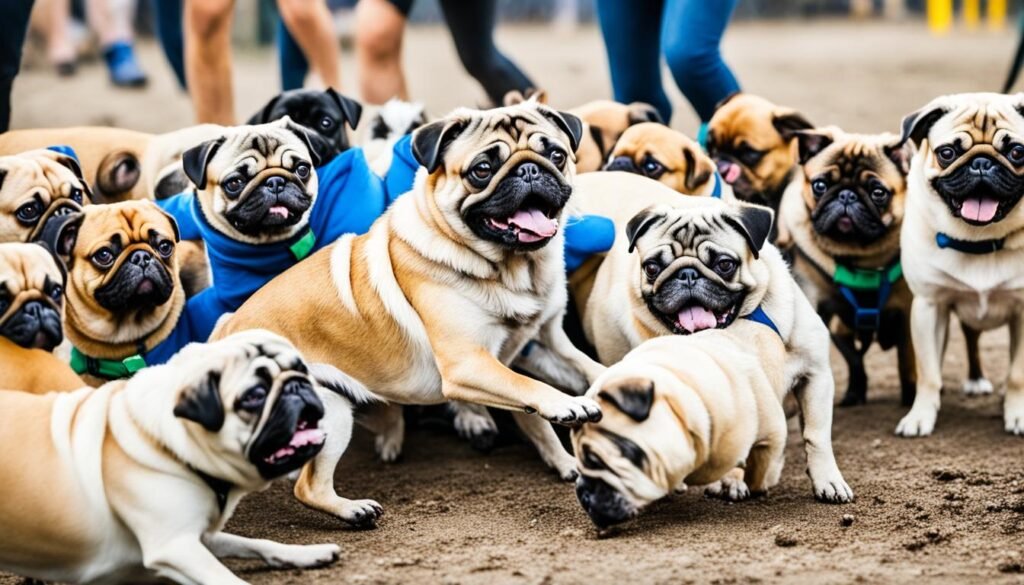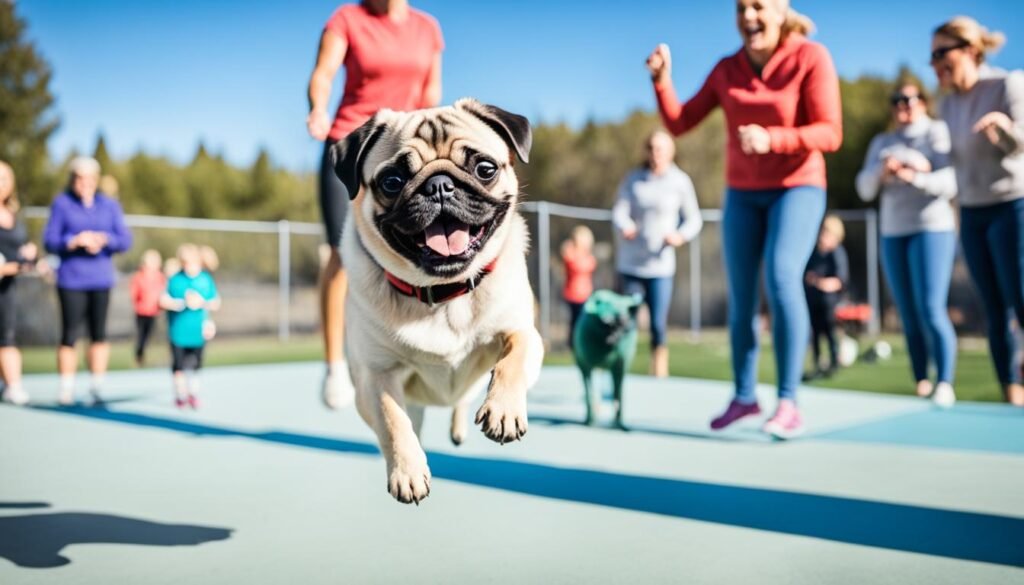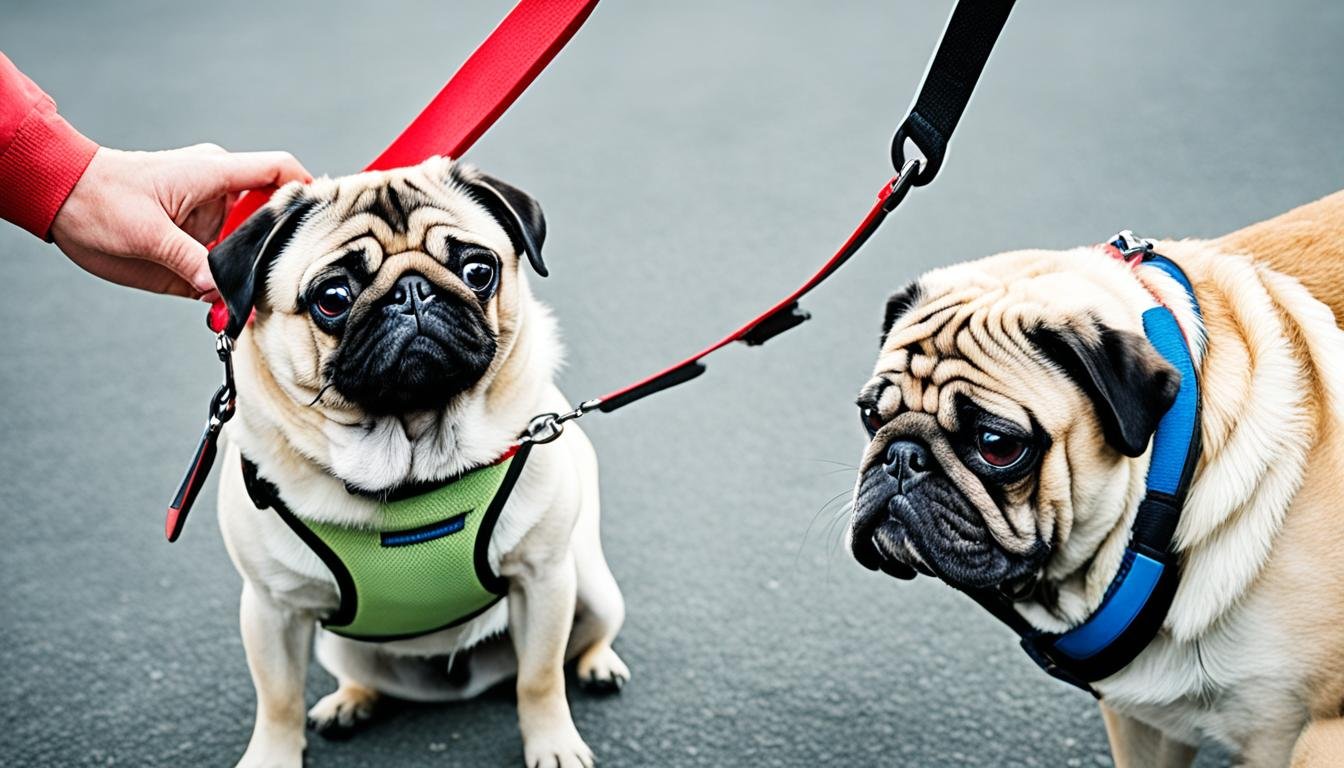The Biggest Mistakes People Make When Introducing Pugs to Other Pets
Introducing a new pug to other pets can be a challenging process if not done correctly. It is important to avoid common mistakes in order to ensure a smooth integration and prevent potential conflicts between the pug and other animals. This section will outline the biggest mistakes people make when introducing pugs to other pets, providing valuable insights to help pet owners navigate this process successfully.
Mistake 1: Meeting face to face on a leash
One of the most common mistakes people make is allowing their pug to meet another pet face to face while on a leash. This can create tension and aggression between the animals, as leashes can restrict their movements and create a sense of vulnerability.
It is best to allow the pets to interact in a more neutral environment, such as a park or open space, without the restriction of leashes. This gives them the opportunity to establish a natural hierarchy and communicate through body language.
By meeting off-leash, both pets have the freedom to move and react more naturally. They can sniff, investigate, and establish boundaries without feeling confined. This can significantly reduce the likelihood of pug leash aggression and promote a more positive introduction.
Remember, the first meeting between pets is crucial, and setting the stage for success is essential. Taking the time to provide a safe and unrestricted environment for introductions can help foster a harmonious relationship between your pug and other pets.
Mistake 2: Not paying attention to their behavior & body language
When introducing your pug to other pets, it’s important to observe and understand their behavior and body language. This is a common mistake that pet owners make, but it can have significant consequences. By paying attention to their behavior, you can identify signs of aggression, fear, or discomfort, which can help prevent potential conflicts.
Understanding pug behavior and body language is key to a successful introduction. Pugs have their unique way of communicating, and it’s crucial to interpret their cues correctly. For example, a stiff body posture, raised hackles, or intense staring could indicate signs of aggression. On the other hand, a relaxed body, wagging tail, and play bow can indicate a positive interaction.

During introductions, it’s not just the pug’s behavior that you should pay attention to. You also need to observe the behavior of the other pet. Look for signs of anxiety, fear, or aggression in the other animal. These signs can include growling, bared teeth, or a defensive posture.
By closely observing your pug and the other pet’s behavior, you can intervene if necessary and prevent any potential conflicts. It’s important to give both pets enough space and time to adjust to each other. Remember, a gradual and controlled introduction is key to a successful integration.
Mistake 3: Introducing dogs in a dog park
When it comes to introducing pugs to other pets, many people mistakenly opt for a dog park setting. However, dog parks can pose a number of challenges and dangers for pugs, undermining their socialization and potentially causing distress.
Pugs, known for their lovable and gentle nature, may find the hustle and bustle of a dog park overwhelming. Their small size makes them more vulnerable to accidents or injuries in an environment with unfamiliar dogs running around.
While socialization is important for pugs, it is crucial to do it in a controlled and calm setting. Dog parks may not provide the right environment for pug socialization, as the presence of numerous dogs can be intimidating and lead to increased anxiety.
Additionally, dog parks often lack adequate supervision, increasing the risk of conflicts between dogs. Pugs, with their docile temperament, may be less equipped to handle such situations and may become targets of aggressive behavior.
To ensure the safety and well-being of your pug, consider alternative options for socialization, such as playdates with other calm and friendly dogs or joining obedience classes specifically designed for small breeds. These controlled environments can allow your pug to gradually build confidence and positive associations with other dogs.

Mistake 4: Neglecting socialization and obedience training
Neglecting socialization and obedience training is another common mistake when introducing pugs to other pets. Pugs, just like any other breed, require proper socialization and obedience training to thrive in their interactions with other animals.
When it comes to pug socialization and training, consistency and patience are key. It is important to expose your pug to different environments, people, and animals from a young age. This helps them become comfortable and confident in various social settings.
Obedience training plays a crucial role in establishing boundaries and commands for your pug. By teaching them basic obedience commands such as sit, stay, and come, you can ensure their safety and prevent potential conflicts with other pets. Obedience training also helps pugs understand their place in the family hierarchy, leading to a more balanced and harmonious relationship with other animals.
The importance of socialization for pugs cannot be emphasized enough. Proper socialization ensures that your pug develops positive behavior and communication skills, enabling them to interact appropriately with other pets. It also helps prevent behavioral issues that may arise from fear or lack of exposure to different situations.
Investing time and effort in pug socialization and obedience training is essential for their overall well-being and successful integration with other pets. By providing them with the necessary tools and training, you set your pug up for a lifetime of positive interactions and companionship.

Mistake 5: Not gradually introducing the new dog to the existing pet
A crucial mistake to avoid when introducing a new pug to your existing pet is not taking a gradual approach. Suddenly bringing the two animals together can lead to conflicts and territorial disputes. To ensure a smoother integration process, it is essential to introduce the pug to the existing pet gradually.
Start by allowing them to become familiar with each other’s scent. You can do this by exchanging bedding or using a blanket that carries the scent of one animal and placing it near the other. This gradual introduction helps reduce stress and allows the pets to become more comfortable with one another.
Supervised interactions are essential during this process. Keep the pets in separate spaces at first, such as using baby gates to create a barrier between them. Allow them to see each other, sniff, and observe from a safe distance. Over time, you can gradually increase their supervised interactions, always keeping a watchful eye for any signs of aggression or tension.
By following this gradual approach to introducing pugs to existing dogs, you can minimize the chances of conflicts and ensure a smoother integration process. Remember to be patient and give your pets the time they need to adjust to one another. With proper supervision and a gradual pet integration process, they can become great companions in no time.

